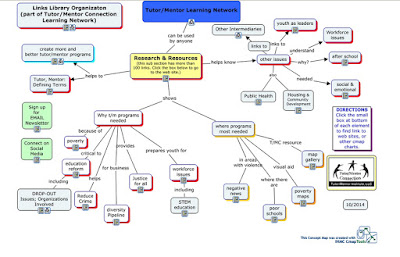Below is a concept map that visualizes the African proverb: "It takes a village to raise a child."
If you click here, you can find 30 articles where I've used this "It Takes a Village" concept since I started this blog in 2005. I use the ideas as a strategy that needs to be growing in cities all across the country, and demonstrated with web sites that show a commitment visualized in the strategy map below.

When people in business, media, entertainment, politics, religion, education, colleges, and every other part of the "village" adopt this commitment, with themselves shown in the blue box at the top of the graphic, then we can begin to build the public will and long-term commitment needed to fill every high poverty neighborhood in a city with a wide range of supports needed to help kids move successfully and safely from birth to adult lives free of poverty.
Over time that would have led to consistent funding and volunteer support to tutor/mentor programs in every high poverty area of the region.
How to get started? Make a leadership commitment, as a teacher, a college professor, a Rabbi, a CEO, then appoint someone to take the lead. Start a learning process, where you open and close every node on the strategy map so you know the information it's sharing, and you know what your commitment involves.
View these presentations, created by interns, as part of their own learning between 2006 and 2015. Youth and adults could be creating similar presentations, focusing on their community and their strategies.
Create a version of the strategy map and share it on your website and blog. Teach others to use it.
Raising kids and helping them be healthy, productive, contributing adults who can keep America great, and keep this planet safe and nurturing of all of its different populations and resources...human, animal, plant... is something that everyone should be able to agree on.
It does take a village. But until we have responsible, on-going, commitments of time, talent and dollars from every part of the village, supporting youth in the most economically challenged parts of every city, these will just be empty words.
That means students, volunteers, college researchers, and others will need to learn to create maps that show who in the village is involved, and who is still not involved. You can see some examples of event mapping of past Tutor/Mentor Leadership and Networking Conferences, at this link. Many different forms of mapping are highlighted in articles on the Mappingforjustice blog.
Part of the learning that people do will need to include finding ways to map participation .
I've been posting ideas on this blog, on web sites and in printed newsletters since 1994. The tags on the side of this blog are shown in this graphic, and in articles like this, in an effort to help people navigate through this vast web of information and ideas.
If you share this commitment, please share this and other ideas shared on this blog and my Tutor/Mentor Institute, LLC web site. Help build the village in every part of the country.
Please connect with me on Twitter, Facebook, Instagram and LinkedIn.
If you value the ideas I'm sharing, please visit this page and send a small contribution.










































